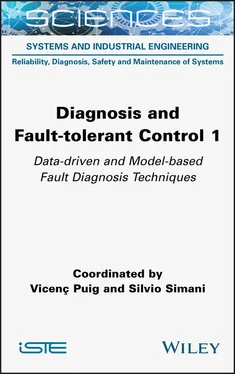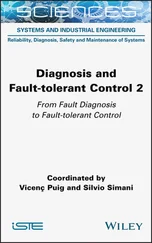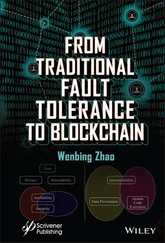Chapter 1addresses the mathematical modeling and description of the faults most commonly exploited for providing a proper description of the process under diagnosis, in connection with the strategy proposed for the diagnosis and FTC designs.
By taking into account these aspects, Chapter 2is focused on structural analysis issues. In particular, this chapter addresses the standard tool used to identify submodels that can be used to design model-based and data-driven diagnostic modules. Structural approaches typically operate on models described by a set of equations, which can also be obtained from model-free approaches.
With reference to FDI, Chapter 3considers set-based methods. The set-membership and interval observer approaches are introduced to deal with the robustness problem in fault detection. The design conditions to guarantee robustness, and at the same time fault sensitivity, are presented. Next, the extension to fault isolation using unknown-input observer schemes is described.
Chapter 4describes stochastic methods for FDI. In particular, the chapter revises the existing methods for FDI using stochastic modeling of uncertainty, using both models and data.
As an alternative to analytical approaches, Chapter 5proposes data-driven schemes. It is therefore devoted to the problem of fault detection in technical systems described by nonlinear dynamical models containing non-smooth nonlinearities. The so-called “model-free” or “data-driven” solutions can be exploited to solve the considered FTD and FTC problems. The feature of this method is that parameters of the system under consideration may be unknown.
Among data-driven solutions, Chapter 6considers the artificial intelligence (AI) approach to fault diagnosis. After revising the evolution of fault diagnosis methods in the AI domain, the chapter focuses on the model-based approach rooted in the logic theory of diagnosis.
When considering analytical approaches, Chapter 1 of Volume 2 proposes the development of nonlinear methods. This chapter gives a review of the principal model-based fault diagnosis and fault-tolerant approaches for nonlinear systems. Some schemes extending the well-known diagnosis methods for linear systems to the nonlinear case are considered. The robustness of these schemes in the presence of uncertainty is discussed. Similarities between the approaches considered are also pointed out.
With reference to Volume 2, the problem of the FTC is addressed. In particular, Chapter 2 of Volume 2 considers the use of linear parameter varying (LPV) methods. In particular, this chapter considers FDI and FTC for descriptor LPV systems with unmeasurable decision variables under actuator faults and perturbations.
A different approach is considered in Chapter 3 of Volume 2, where fuzzy Takagi–Sugeno and neural network methods for FDI and FTC are revised. After introducing the different types of models, their application to fault diagnosis and estimation is presented. The extension to FTC is then described.
Chapter 4 of Volume 2 presents the model predictive control (MPC) techniques to deal with robustness and nonlinearity. To this aim, the use of neural networks is considered.
Chapter 5 of Volume 2 considers nonlinear methods for FTC. This chapter presents a methodology for detecting, isolating and accommodating faults in a class of nonlinear dynamic systems. On the basis of the fault information obtained by the fault-diagnosis procedure, an FTC component is designed to compensate for the effects of faults.
Chapter 6 of Volume 2 proposes virtual sensor and actuator development. The problem of FTC for dynamic processes is considered by using virtual sensor/actuator approaches to deal with sensor and actuator faults. This chapter also presents the extension to LPV systems using the Linear Matrix Inequality (LMI) approach.
Finally, Chapters 7 and 8 of Volume 2 complete the book by providing some concluding remarks and open research directions.
In particular, Chapter 7 of Volume 2 summarizes the main achievements of the book by highlighting the key features of the proposed diagnosis and fault-tolerant solutions when applied to safety critical systems.
Finally, Chapter 8 of Volume 2 analyzes some perspectives in the field of diagnosis and FTC by exploring open problems and future issues that could require further investigation. Future possible research directions are also outlined.
Therefore, the book reviews the state of the art of the data-driven and model-based FDI and FTC. The FDI and FTC problems are formalized in an uniform framework by presenting the mathematical description and definitions. The fundamental issue of model-based methods is the generation of residuals using the mathematical model of the monitored system. By analyzing residuals, fault diagnosis and FTC can be performed. Some structures of the residual generator are recalled to give ideas as to how to implement the residual generation. A residual generator can be designed for achieving the required diagnosis performances, for example, fault isolation and disturbance decoupling.
In order to design the residual generator, some assumptions about the modeling uncertainties need to be made. The most frequently used hypothesis is that the modeling uncertainty is expressed as a disturbance term in the system dynamic equation. The disturbance vector is unknown, while its distribution matrix can be estimated by using identification procedures. On the basis of this assumption, the disturbance decoupling residual generator can be designed by using UIO methods Chen and Patton (1999); Liu and Patton (1998).
The book also demonstrates how to apply dynamic system identification methods and more general data-driven approaches in order to estimate an accurate model of the monitored system.
The FDI and FTC methods presented can, in fact, require a mathematical model of the process under investigation, either in a state–space or an input–output form.
In particular, since state–space descriptions provide general and mathematically rigorous tools for system modeling, they may be used in the residual generator design, both for the deterministic case (generalized observers, such as UIOs and output dynamic observers) (Chen and Patton (1999); Frank (1990); Luenberger (1979); Watanabe and Himmelblau (1982)) and the stochastic case (such as Kalman filters and unknown input Kalman filters) (Jazwinski (1970); Xie et al . (1994); Xie and Soh (1994)).
In such a manner, the suggested FDI and FTC tools may not require any physical knowledge of the process under observation since the linear models are obtained by means of an identification scheme, which can, for example, exploit equation error (EE) and errors-in-variables (EIV) models. In this situation, the identification technique is based on the rules of the Frisch scheme (Frisch 1934), traditionally exploited to analyze economic systems. This approach, modified to be applied to dynamic system identification (Kalman 1982b, 1990; Beghelli et al . 1990), gives a reliable model of the plant under investigation, as well as the variances of the input–output noises affecting the data.
For the nonlinear case, fuzzy models and neural networks can be used as prototypes for the identification. In particular, the multiple-model approach, using several local affine submodels each describing a different operating condition of the process, is exploited.
Under these considerations, this book aims to define a comprehensive methodology for actuator, process component and sensor fault detection. It is based on an output estimation approach, in conjunction with residual processing schemes, which include simple threshold detection, in a deterministic case, as well as statistical analysis when data are affected by noise. The final result consists of a strategy based on fault diagnosis methods well known in the literature for generating redundant residuals.
Читать дальше












